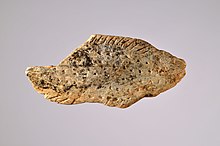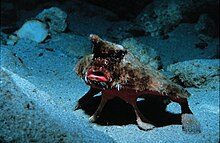fishes
The division of living beings into systematics is a continuous subject of research. Different systematic classifications exist side by side and one after the other. The taxon treated here has become obsolete due to new research or is not part of the group systematics presented in the German-language Wikipedia.

Fish or Pisces ( Latin piscis "fish") are aquatic living vertebrates with gills . In the narrower sense, the term fish is used restricted to aquatic animals with jaws . In a broader sense, it also includes jawless ones , which are still represented by the round-mouthed species among the recent species . In both cases, at least one descendant of the fish (namely the terrestrial vertebrate ) is missing from their community of descent. Therefore the fish do not form a closed community of descent in the biological system , but a paraphyletic taxon . They are just an incomplete community of descent, consisting of a youngest ancestor and the aquatic part of his descendants.
The study of the biology of fish is ichthyology ( ancient Greek ἰχθύς ichthýs "fish") or ichthyology .
etymology
The common Germanic noun mhd. Visch , ahd. Fisk has non- Germanic equivalents only in Latin piscis and air. īasc .
Systematics






In a narrow sense, the fish are not to the land vertebrates belonging gnathostomes . Among the animal groups living today, these include:
- Cartilaginous fish with the sharks , rays and sea cats that live almost exclusively in the sea ;
- Bony fish in the broader sense, composed of meat fins and ray fins . The meatfin fish include the marine coelacanth and the lungfish that live in the fresh water of the southern hemisphere . The ray fins include all other fish groups, including all European freshwater fish .
Further fish taxa belonging to the jaw mouths, but which have only been handed down in fossil form and have been extinct since ancient times , are represented by the:
- Placodermi and the
- Spiny sharks (Acanthodii).
In a broader sense, the jawless are also counted among the fish :
- the recent round mouths - hagfish and lampreys
- various extinct groups that are grouped together as the Ostracodermi .
This results in the following internal system of fish (in the broader sense):
- fishes
-
Jaw mouths (Gnathostomata) without terrestrial vertebrates (LWT)
- † Placodermi
- Eugnathostomata (jaw-mouth crown group) without LWT
- Cartilaginous fish (Chondrichthyes)
-
Teleostomi without LWT
- † spiny sharks (Acanthodii)
- Euteleostomi without LWT (= bony fish (Osteichthyes))
-
Jawless (agnatha)
- † Ostracodermi
- Round mouths (Cyclostomata)
-
Jaw mouths (Gnathostomata) without terrestrial vertebrates (LWT)
The jaw mouths (including the land vertebrates) are a monophyletic taxon ( clade ), but without the land vertebrates they are paraphyletic because they do not contain all descendants of their common ancestor. Hence the fish taxon is (in the narrower sense) paraphyletic.
The jawless ones are considered paraphyletic. Therefore the taxon of the fish would also be paraphyletic (in the broader sense) if either the jaw mouths were descended from the jawless ones, or vice versa (both are considered plausible). That would also apply if the jawless were monophyletic, since the jaws (without terrestrial vertebrates) are already paraphyletic. However, if neither group were descended from the other, the fish would be (in the broader sense) polyphyletic because they did not contain their most recent common ancestor.
Since fish are not a monophyletic taxon in the sense of cladistics , they are often written in quotation marks in the zoological system (“fish”, “pisces”) to identify them as a non-monophyletic taxon.
Evolution and biodiversity
The oldest known jawless fish-like species (e.g. the Pteraspidomorphi ) date from the early Ordovician around 450–470 million years ago. The cartilaginous fish appear from the Silurian / Devonian border about 420 million years ago. Bony fish have existed in the sea since the Devonian, but they may also have started developing in the Silurian.
A little over half of all living vertebrate species, namely currently around 32,500 species according to FishBase (as of April 2013), belong to the "fish" category. The number of recognized (so-called “valid”) species is changing on the one hand due to numerous new discoveries, on the other hand due to continuous taxonomic revisions of individual fish groups.
Danger
Since 1984, the regular proclamation of one species (exceptionally also a group of related species) as German fish of the year has been intended to draw attention to the ecological endangerment of fish, especially in Germany . Some species, such as the brown trout , have already been named fish of the year twice. An Austrian fish of the year has also been named since 2002, and a Swiss fish of the year since 2010 . In some places fish ladders were built to enable fish to migrate across power plants and dams . In addition, some rivers have been renatured in order to make them attractive again as a habitat for fish.
meaning
economy
The fishing of edible fish is important from an economic point of view , but also the trade in ornamental fish . However, fishing can threaten fish stocks. Pollution, river barriers, warming , release of alien species and dehydration are further dangers for the fish.
Ecotoxicology
Fish are directly exposed to water quality (oxygen concentration, pH value, temperature, dissolved natural and anthropogenic substances) through their gills and react quickly and sensitively to pollution. They therefore also serve as widespread test and monitoring types and as scientific model organisms in ecotoxicology .
Culture
The fish serves as a symbol and identification mark in Christianity and is a common heraldic animal. In China, the fish was a symbol of wealth due to the fact that it was sound.
A fish book by Pierre Belon , published in Paris in 1551, contains the first significant fish images . First in German printed work with lifelike representations of fish by Alexander and Samuel White Horn in Ingolstadt printed applies Vischordnung , manufactured by 1553 (with in the also in the printing Weißenhorn Bavarian order 1553 ( Bairische Lanndtsordnung ) woodcuts used that may to go back to the Munich court painter and woodcut draftsman Caspar Clofigl).
Fish in Paleolithic Art
In Paleolithic art - in addition to mammoths, wild horses and lions - fish were also represented. During archaeological excavations in the overburden of the Vogelherd cave ( Swabian Alb ), a fragmented figure of a fish was discovered in 2008. The almost five centimeter tall sculpture made of mammoth ivory comes from the Aurignacia and is part of the UNESCO World Heritage " Caves and Ice Age Art in the Swabian Jura ". Like 15 other artefacts, it is exhibited in the Museum of Ancient Cultures in Hohentübingen Castle .
Sensation of pain
For a long time it was unclear whether fish feel pain. There are now a number of studies that prove this pain perception. As a result, the American Veterinarian Medical Association is calling for the same measures to be taken on fish to relieve pain that are taken on mammals.
See also
For anatomy, physiology and reproductive biology, see bony fish .
Ichthyological literature
- Quentin Bone, Richard H. Moore: Biology of Fishes . 3rd edition, Taylor & Francis, 2008, ISBN 978-0-415-37562-7 .
- Thomas Braunbeck, David E. Hinton, Bruno Streit: Fish Ecotoxicology . Birkhäuser, Basel-Berlin-Boston 1998, ISBN 3-7643-5819-X .
- Ch. M. Danoff, J. Wiesner, JE Skydsgaard: Fish. In: Lexicon of the Old World . 1990, Vol. 1, Col. 971-977.
- Kurt Fiedler: Textbook of Special Zoology (2nd volume, 2nd part: fish) . Gustav Fischer Verlag., Jena 1991, ISBN 3-334-00339-6 .
- Karl A. Frickhinger: Mergus fossil atlas fish . Mergus Verlag, Melle 1991, ISBN 3-88244-018-X .
- Harald Gebhardt, Andreas Ness: Fish. The native freshwater fish as well as species from the North and Baltic Seas . 7th edition, BLV Verlag, Munich 2005, ISBN 3-405-15106-6 .
- Wilfried Westheide , Reinhard Rieger: Special Zoology. Part 2: vertebrates or skulls. Spectrum Akademischer Verlag, Heidelberg 2004, ISBN 3-8274-0900-4 .
Web links
- FishBase - database of described fish species (31,500 species)
- FischDB - fish database, contains biochemical data
- Pisces - anatomy
- Aqua4Fish: Fish Atlas - Datasheets
- Freshwater fish directory
- Red list, literature and database on native fish, lampreys and crabs
- Information on fish from the Senckenberg Natural History Museum , Frankfurt am Main
- World of Fish - current list of all new fish species, with links to abstracts / descriptions
Individual evidence
- ^ The dictionary of origin (= Der Duden in twelve volumes . Volume 7 ). Reprint of the 2nd edition. Dudenverlag, Mannheim 1997 ( p. 190 ). See also Friedrich Kluge : Etymological dictionary of the German language . 7th edition. Trübner, Strasbourg 1910 ( p. 137 ).
- ↑ Philippe Janvier: microRNAs revive old views about jawless vertebrate divergence and evolution . Comment. In: PNAS . tape 107 , no. 45 . National Academy of Sciences, November 9, 2010, ISSN 1091-6490 , p. 19137-19138 , doi : 10.1073 / pnas.1014583107 .
- ↑ Global warming drives fish to higher altitudes . In: fischereiberatung.ch, accessed on February 8, 2019 (PDF; 278 KB)
- ^ Heinrich Grimm: New contributions to the "fish literature" of the XV. to XVII. Century and through their printer and bookkeeper. In: Börsenblatt for the German book trade - Frankfurt edition. No. 89, November 5, 1968 (= Archive for the History of Books. Volume 62), pp. 2871–2887, here: pp. 2871, 2876 f., 2879 f. and 2882 f.
- ↑ What fish know . ( heyn.at [accessed October 15, 2018]).
- ^ S Leary, Wendy Underwood, R Anthony, Samuel Cartner, Douglas Corey: AVMA Guidelines for the euthanasia of animals: 2013 Edition . In: J Am Vet Med Assoc . January 1, 2013, p. 1–102 ( researchgate.net [accessed October 15, 2018]).
